The Pulse Project Evaluation
Since 2016, Child Trends has collaborated with Healthy Teen Network to evaluate Pulse, a web-based mobile health app designed for Black and Latinx women ages 18–20. Through culturally responsive and engaging content, Pulse provides its audience with information on birth control, healthy relationships, sexual health and physiology, pregnancy, and utilization of clinical services. The content is designed to help women who do not want to become pregnant choose effective birth control, seek reproductive health services, and, ultimately, prevent unplanned pregnancies.
Related Documents:
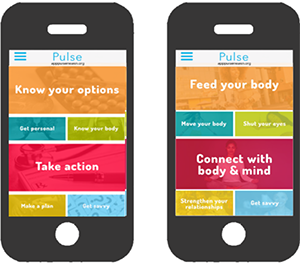 This resource introduces the Pulse intervention and describes Child Trends’ unique approach to evaluating Pulse’s impact on pregnancy among older teens. For this intervention, Child Trends recruited a sample of more than 2,300 young women completely online. The study team was able to retain most of these women for the duration of the intervention and post-test survey administration by using both the app and pre-programmed, automatically delivered text messages.
This resource introduces the Pulse intervention and describes Child Trends’ unique approach to evaluating Pulse’s impact on pregnancy among older teens. For this intervention, Child Trends recruited a sample of more than 2,300 young women completely online. The study team was able to retain most of these women for the duration of the intervention and post-test survey administration by using both the app and pre-programmed, automatically delivered text messages.
Presentation – Sex Research in Cyberspace
- Accepted at the Society for Adolescent Health and Medicine (SAHM) conference, March 11-14, 2020. Cancelled due to Coronavirus. Presented at Office of Population Affairs’ Teen Pregnancy Prevention Tier 2 Showcase Webinar, March 3, 2020, and at Healthy Teen Network’s Annual Conference, October 28-30, 2019, by Jennifer Manlove, Elizabeth Cook, Brooke Whitfield, and Jane Finocharo (Child Trends); and by Genevieve Martínez-García, Milagros Garrido, and Nicholas Sufrinko (Healthy Teen Network).
- Description: This presentation introduces the Pulse intervention and evaluation, discusses lessons learned from an online intervention, and highlights promising short-term impact findings.
Blog – Let’s See: Pulse Short-Term Impact Results
- From 2016 to 2019, Child Trends conducted a randomized control trial to evaluate the impact of Pulse on the incidence of unprotected sex and on young women’s contraceptive knowledge, attitudes, self-efficacy, and intentions. This blog summarizes the impact findings from the six-week, short-term follow-up survey that were published by the study team in the Journal of Adolescent Health.
Short-term impacts of Pulse, a teen pregnancy prevention app
- From 2016 to 2019, Child Trends conducted a randomized control trial to evaluate the impact of Pulse on the incidence of unprotected sex and on young women’s contraceptive knowledge, attitudes, self-efficacy, and intentions. This research brief summarizes the impact findings from the six-week, short-term follow-up survey that were published by the study team in the Journal of Adolescent Health.
Blog – Best practices for enrolling young women in online research studies
- Online recruitment is an innovative and cost-effective way to reach potential participants for research studies. Through social media advertisements, researchers can recruit from a large and diverse population. However, without the face-to-face interactions and personal follow-ups that traditional recruitment methods employ, online recruitment efforts may have difficulty building the trust and credibility needed to get sufficient numbers of eligible potential study participants to complete the enrollment process. This blog offers tips for researchers on how to recruit their desired sample size using online enrollment.
Evaluating Young Women’s Engagement with an Online Reproductive Health App
- This research brief highlights the characteristics of women who participated in the Pulse program, their differing levels of engagement with the mobile app, and the characteristics of the participants who engaged with the app versus those who had little or no engagement. Results provide important lessons about the types of young women who can be effectively reached through a solely tech-based pregnancy prevention program.
 Many existing health programs and interventions reach only a portion of the population in need. As a result, practitioners increasingly use tech-based interventions to deliver services to hard-to-reach populations. Because mobile devices are becoming universal, innovative service delivery methods can use mobile apps and text messaging to effectively reach some of these historically hard-to-reach groups—particularly older teens and young adults. This blog discusses the importance of continuously improving user experience with these types of interventions.
Many existing health programs and interventions reach only a portion of the population in need. As a result, practitioners increasingly use tech-based interventions to deliver services to hard-to-reach populations. Because mobile devices are becoming universal, innovative service delivery methods can use mobile apps and text messaging to effectively reach some of these historically hard-to-reach groups—particularly older teens and young adults. This blog discusses the importance of continuously improving user experience with these types of interventions.
Blog – Identifying scammers in online studies
- AEA 365 blog. Health interventions have increasingly incorporated technology components, sometimes even using technology to recruit participants. Identifying suspicious accounts can be a difficult, time-consuming process for online interventions—but it’s also a necessary one. Study teams involved in similar online interventions are encouraged to consider the tips presented in this blog when developing study procedures.
- Healthy Teen Network blog. This blog post builds on the content in the AEA 365 blog, diving deeper into avoiding scammers in online studies. Such studies present unique advantages, including the needs to be cost-efficient, provide researchers with a large recruitment pool, and allow participants to remain anonymous. However, ensuring that participants are who they claim to be represents a challenge that accompanies this form of recruitment. This blog addresses the issue by presenting tips from an evaluation of a strictly technology-based intervention.
Roundtable Discussion – Sex ed + tech: Using innovation to evaluate a sex ed digital intervention
- Presented at American Public Health Association’s 2018 Annual Meeting, November 10–14, 2018, by Elizabeth Cook and Jennifer Manlove
- Description: This roundtable session provided an overview of the Pulse app, the recruitment and research process, and the key lessons learned. The session discussed the importance of branding, social media channels as effective means of online recruitment, strategic targeting in online recruitment, and identifying scammers and duplicates in study samples.
Poster – Sex ed goes high tech: Findings from a RCT evaluation of the Pulse app

- Accepted at the Population Association of America (PAA) Annual Meeting, April 22-25, 2020. Cancelled due to Coronavirus. Accepted at the Society for Adolescent Health and Medicine (SAHM) conference, March 11-14, 2020. Cancelled due to Coronavirus. Presented at American Public Health Association’s 2018 Annual Meeting, November 10-14, 2018, and at Family & Youth Services Bureau’s 2018 Adolescent Pregnancy Prevention Conference, May 30-31, 2018, by Jennifer Manlove, Elizabeth Cook, Brooke Whitfield, Makedah Johnson, and Jane Finocharo (Child Trends), Milagros Garrido, Nicholas Sufrinko, and Genevieve Martínez-García (Healthy Teen Network)
- Description: This poster provides descriptive characteristics, app usage information, and text message data from Child Trends’ evaluation of Pulse. It also includes short-term impact results for outcomes related to behaviors, attitudes, self-efficacy, and intentions.
Presentation – Pulse: Evaluating a pregnancy prevention mobile app for older adolescents nationwide
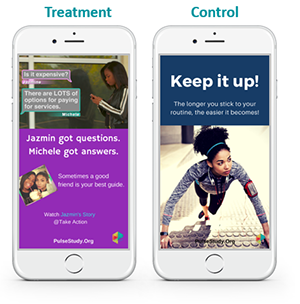 Presented at American Evaluation Association’s 2017 Annual Conference, November 8-11, 2017, by Elizabeth Cook, Jennifer Manlove, Makedah Johnson
Presented at American Evaluation Association’s 2017 Annual Conference, November 8-11, 2017, by Elizabeth Cook, Jennifer Manlove, Makedah Johnson- Description: This presentation provides a brief overview of the design of Child Trends’ evaluation of Pulse. This presentation was given as one segment of a three-part presentation with Healthy Teen Network and the University of California, San Francisco, and presents study characteristics, recruitment and enrollment processes, and the process of identifying and removing suspicious accounts from the study.
Poster – Likes, tweets, and hashtags: Harnessing the power of social media for study recruitment
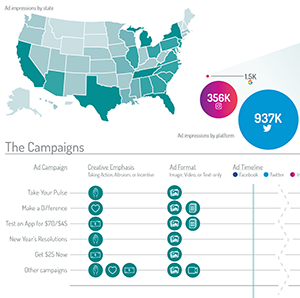 Presented at Healthy Teen Network’s 2017 Annual Conference, October 3-4, 2017, by Nicholas Sufrinko, Milagros Garrido, and Genevieve Martínez-García (Healthy Teen Network), Jennifer Manlove, Elizabeth Cook, and Makedah Johnson (Child Trends)
Presented at Healthy Teen Network’s 2017 Annual Conference, October 3-4, 2017, by Nicholas Sufrinko, Milagros Garrido, and Genevieve Martínez-García (Healthy Teen Network), Jennifer Manlove, Elizabeth Cook, and Makedah Johnson (Child Trends)- Description: This poster provides an overview of how the authors used social media advertisements to recruit and enroll participants for Child Trends’ evaluation of Pulse. It also provides a detailed timeline of when a subset of ads was employed throughout the study, along with several lessons learned from the online recruitment process.
Poster – Pulse, an app in action: Preliminary usage results from a randomized control trial
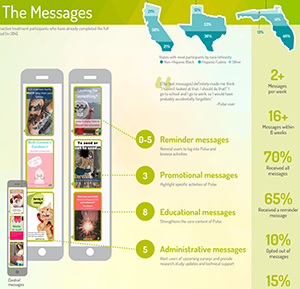 Presented at Healthy Teen Network’s 2017 Annual Conference, October 3-4, 2017, by Jennifer Manlove, Elizabeth Cook, Brooke Whitfield, and Makedah Johnson (Child Trends), Milagros Garrido, Nicholas Sufrinko, and Genevieve Martínez-García (Healthy Teen Network)
Presented at Healthy Teen Network’s 2017 Annual Conference, October 3-4, 2017, by Jennifer Manlove, Elizabeth Cook, Brooke Whitfield, and Makedah Johnson (Child Trends), Milagros Garrido, Nicholas Sufrinko, and Genevieve Martínez-García (Healthy Teen Network)- Description: This poster provides descriptive characteristics of the first cohort of 754 participants in Child Trends’ evaluation of Pulse. It also provides preliminary results for how often the app was visited and the types of text messages that were delivered to participants, and from in-depth interviews with several participants.
Poster – Teen pregnancy research 2.0: Taking sexual health research to the mobile world
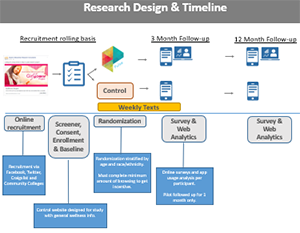 Presented at the Health & Human Services’ 2016 Teen Pregnancy Prevention Grantee Conference, July 19-21, 2016, by Genevieve Martínez García, Mila Garrido, Yewande Olugbade, Alex Eisler, Pat Paluzzi, Kelly Connelly (Healthy Teen Network), Jennifer Manlove, Elizabeth Cook (Child Trends)
Presented at the Health & Human Services’ 2016 Teen Pregnancy Prevention Grantee Conference, July 19-21, 2016, by Genevieve Martínez García, Mila Garrido, Yewande Olugbade, Alex Eisler, Pat Paluzzi, Kelly Connelly (Healthy Teen Network), Jennifer Manlove, Elizabeth Cook (Child Trends)- Description: This poster reviews how the authors adapted Crush—a sexual health app designed for teen girls—to create the Pulse app, with the goal of better serving the sexual and reproductive health needs of young women ages 18–20. The poster outlines the research design and projected timeline of Child Trends’ evaluation of Pulse, the major adaptations made to create the app, and lessons learned from the study design process.
© Copyright 2025 ChildTrendsPrivacy Statement
Newsletter SignupLinkedInYouTubeBlueskyInstagram